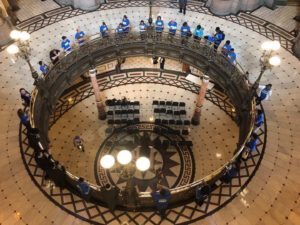Op-Ed: Illinois proves investing in school choice lifts low-income families
Early on July 10, 2015, Jerry Valdivia Sr. was fighting flames to get to his wife and two children in their Chicago home. His wife died trying to shield the youngsters, and both children were…

Early on July 10, 2015, Jerry Valdivia Sr. was fighting flames to get to his wife and two children in their Chicago home. His wife died trying to shield the youngsters, and both children were severely burned.
Valdivia was left to raise his 2-year-old daughter, Kiara, and 6-year-old son, Jerry Jr., alone. They were coping with losing their mother, a new home, plus the pain and disfigurement from burns, skin grafts and other treatments. A crowded Chicago Public Schools classroom with his peers staring at the little boy wearing a mask and special clothes to help him heal was not what Jerry Jr. needed.
Valdivia met a widow with children, and she said they had a choice: Their children could attend St. Ann Catholic Grade School, where classes were smaller and the faith-based community would embrace the children. The principal talked to the students about Jerry Jr., and they rallied around the hurt little boy.
“My main motivation for switching to private school was for them to have that safe space to learn and grow,” Valdivia said. “My stepson, Aiden, had lost his dad the year before I met my wife and the three of them: Jerry Jr., Aiden and Kiara, needed to know their parents were behind them, and they had a community supporting them.”
But private school posed a financial challenge. The Valdivias got help from Illinois’ Invest in Kids, a scholarship program that offers donors a 75% state tax credit when they donate money to help low-income students attend private schools. State lawmakers created the scholarships in 2017 and in 2021 they extended the program’s sunset to 2023. They just passed a bill April 7, awaiting Gov. J.B. Pritzker’s signature, to give top priority for scholarships to students already participating in the program so their educations are not interrupted.
The Valdivia children face that prospect. They were among the 9,029 students awarded an Invest in Kids scholarship this school year. In 2021, another 26,000 K-12 students were placed on a waitlist after they qualified through Empower Illinois, which granted over two-thirds of the state’s scholarships. The Valdivia kids might join them next year. They were wait-listed.
This is why it is critical Pritzker now support lawmakers’ effort to give past recipients super-priority status and allow more partial scholarships to be awarded. The Valdivia family deserves certainty to know their children’s education will be there for them for years to come.
The rest of Illinois’ children do, too. Those thousands of children, who by chance were born into families less able to afford private school, deserve a chance to succeed. Whether their public school is failing, their classes are crowded, they require more individual attention or faith fuels their aspirations, they should be able to obtain the education that best meets their needs.
State lawmakers keep putting off making Invest in Kids permanent, or at least giving it a reasonable lifespan. Their tweaks won’t do any good if thousands of children are left without an option when the program expires in 2023. Lawmakers must not only secure the program’s future, but they should also expand it to pre-K students, increase the tax credit to 100% of a donation or allow the other 25% to be deductible against federal taxes and allow business donors to target their gifts to specific schools, as individual donors presently can. They should also consider increasing the maximum credits available because there are more than enough donations to claim the current tax credits.
And why not give this program a solid future? Private school families still pay taxes that support public schools, which means one less student crowding a public classroom, and it saves taxpayers at least $3,000 per scholarship. Illinois expects to spend $9.7 billion on education in the coming year: Invest in Kids represents a fraction of a percent of that at $75 million in credits, which puts $100 million into education that otherwise would not exist.
The average family income was $38,403 for those granted scholarships in 2020 through Empower Illinois, with more than half of their children being minority students.
And the scholarships don’t only lift children. Families benefit, which lifts the greater community.
Jennifer Rodriguez, a teacher in Joliet, Illinois, was able to advance her education because a private school scholarship helped care for her daughter’s needs.
“I’m able to bring myself up as well because I’m now back in school for my master’s,” Rodriguez said. “I might not even have been able to do that if we were paying full tuition. The scholarships have really allowed us to be able to invest in education for our family.”
The Valdivias saw the same dynamic. The scholarships for their children freed resources for a parent’s master’s degree.
“Our family is economically moving forward because of the education that my wife has been able to obtain, and they’re opening doors for our kids,” Valdivia said.
What more could state leaders want from a program? More importantly, Invest in Kids is exactly what Illinoisans want from their state government.



